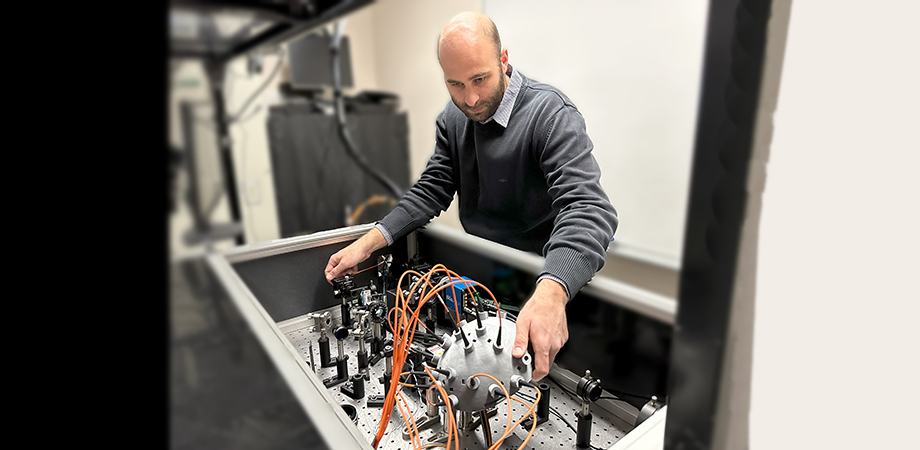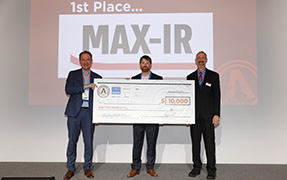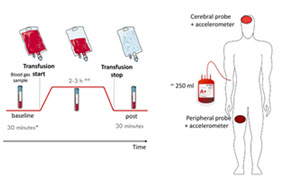Bringing brain imaging up to laser-speckle speed

It was a particular aspect of his doctoral work in nonlinear optics that led Simon Mahler to his current position in Changhuei Yang’s Biophotonics Lab at Caltech. “For my PhD at the Weizmann Institute, I was studying the synchronization of coupled lasers,” says Mahler. “Part of that was studying laser speckles so that I could generate a clean laser beam.” If you want to synchronize a large group of lasers, he explains, they have to be of uniform phase, a key element for intensity modulation. “As a side project, I was studying laser speckles to improve the quality of the laser beams,” says Mahler, “and somehow, while I was studying speckles, I discovered more and more about them, and that small project became bigger and bigger.” By the end of his PhD in 2021, Mahler had spent nearly half of his time studying speckles in order to generate clean laser beams and manipulate them.
“Then I found out that you can use speckles to image bio samples,” he says. “And I thought, ‘That sounds very interesting.’” That interest led to Mahler’s pivot into biomedical optical imaging, combining photonics and biomedical engineering research; his role at Caltech with the lab’s focus on brain imaging; and high-level recognition: In December, Mahler’s project — designing a multi-channel helmet which utilizes near-infrared laser speckle imaging to non-invasively monitor cerebral blood flow in the human head across several locations simultaneously — garnered him the $75,000 SPIE-Franz Hillenkamp Postdoctoral Fellowship in Problem-Driven Biomedical Optics and Analytics, an annual award that supports interdisciplinary research, providing opportunities for translating new technologies into clinical practice for improving human health.
Yet another benefit to switching his path from fundamental to applied research was seeing the results of his work with more immediacy. “When you do fundamental research,” Mahler says, “you often don’t see the real-life application before a long time; when you do engineering or applied research, you see the outcome much more quickly, so you can really see how and why the application is useful. It has a more immediate impact.”
At the moment, the immediate impact of his multi-channel laser device translates to observing the blood flow in brains of people who have suffered a traumatic brain injury from, say, a car accident or a sports-related fall. If the accident damaged part of their skull, that might have required a transparent implant to replace a broken or missing piece. “Right now, I have two subjects with transparent implants on one side of their brain,” says Mahler. “I compare the way my laser device monitors blood flow through the implant and through the skull, looking to see if the device acts the same or different.” This type of blood-flow imaging, he notes, is important because when it comes to surgery, having clear information about blood flow is critical. “I really enjoy working on this project because it’s not only about being in the lab and building a device — it’s not only my experiment,” he explains. “We are also bringing people to the lab and scanning their brain, and I get to see if my device really works and how it works. It’s pretty rewarding to see that my research can help people.”
Interest in imaging brain blood flow is not new, and laser speckle imaging is just one technique alongside others such as MRI and ultrasound, but, as Mahler notes, this is a case of technology catching up to and advancing research. “I think the reason it became famous the last couple of years is because lasers can be made so cheaply now, and you can have such a small compact version. At the same time, cameras and detectors have advanced a lot because we use them every day, as example with our phones.” These recent technological advancements allow researchers to apply laser imaging to the brain that simply wasn’t possible previously, opening up exciting opportunities for biomedical engineers and researchers.
“It makes it pretty competitive too,” he says. “We are not the only ones working on this technology. But it’s also interesting because you have such a wide choice of technology to explore — there are so many different types of lasers and detectors and cameras that you can build your own system and it still will be unique.”
While his Hillenkamp fellowship provides financial support, Mahler envisions many other transformative outcomes. “SPIE is so active in helping to develop our area of research,” he says. “I went to Photonics West last year and found out that I’m not alone; I found many other people using the same imaging technique, and I was really happy to see that. At the conference, we had a place to connect, to share our science, and to have ideas. This fellowship will help me to improve my network, and also to be part of the SPIE community.”
Another outcome, he says, will benefit the global field of brain imaging using laser techniques: “The fellowship will provide a higher profile of my work and, in turn, give more exposure to other research. I think science research is about sharing ideas with each other and making them work. If you’re all alone, it’s hard and sometimes impossible to succeed; if you are with people, whether you’re collaborating or in competition, it drives you to engage, to work harder, and, ideally, to find new ways to apply your work.”
This article was originally published in the Photonics West Show Daily in January 2024.
| Enjoy this article? Get similar news in your inbox |
|



